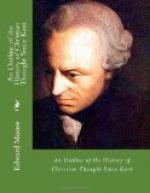The year 1827, in which Keble’s Christian Year was published, saw another change in Newman’s views. Illness and bereavement came to him with awakening effect. He made the acquaintance of Hurrell Froude. Froude brought Newman and Keble together. Henceforth Newman bore no more traces either of evangelicalism or of liberalism. Of Froude it is difficult to speak with confidence. His brother, James Anthony Froude, the historian, author of the Nemesis of Faith, 1848, says that he was gifted, brilliant, enthusiastic. Newman speaks of him with almost boundless praise. Two volumes of his sermons, published after his death in 1836, make the impression neither of learning nor judgment. Clearly he had charm. Possibly he talked himself into a common-room reputation. Newman says: ’Froude made me look with admiration toward the Church of Rome.’ Keble never had felt the liberalism through which Newman had passed. Cradled as the Church of England had been in Puritanism, the latter was to him simply evil. Opinions differing from his own were not simply mistaken, they were sinful. He conceived no religious truth outside the Church of England. In the Christian Year one perceives an influence which Newman strongly felt. It was that of the idea of the sacramental significance of all natural objects or events. Pusey became professor of Hebrew in 1830. He lent the movement academic standing, which the others could not give. He had been in Germany, and had published an Inquiry into the Rationalist Character of German Theology, 1825. He hardly did more than expose the ignorance of Rose. He was himself denounced as a German rationalist who dared to speak of a new era in theology. Pusey, mourning the defection of Newman, whom he deeply loved, gathered in 1846 the forces of the Anglo-Catholics and continued in some sense a leader to the end of his long life in 1882.
The course of political events was fretting the Conservatives intolerably. The agitation for the Reform Bill was taking shape. Sir Robert Peel, the member for Oxford, had introduced a Bill for the emancipation of the Roman Catholics. There was violent commotion in Oxford. Keble and Newman strenuously opposed the measure. In 1830 there was revolution in France. In England the Whigs had come into power. Newman’s mind was excited in the last degree. ‘The vital question,’ he says, ’is this, how are we to keep the Church of England from being liberalised?’ At the end of 1832 Newman and Froude went abroad together. On this journey, as he lay becalmed in the straits of Bonifacio, he wrote his immortal hymn, ‘Lead, Kindly Light.’ He came home assured that he had a work to do. Keble’s Assize Sermon on the National Apostasy, preached in July 1833, on the Sunday after Newman’s return to Oxford, kindled the conflagration which had been long preparing. Newman conceived the idea of the Tracts for the Times as a means of expressing the feelings and propagating the opinions




